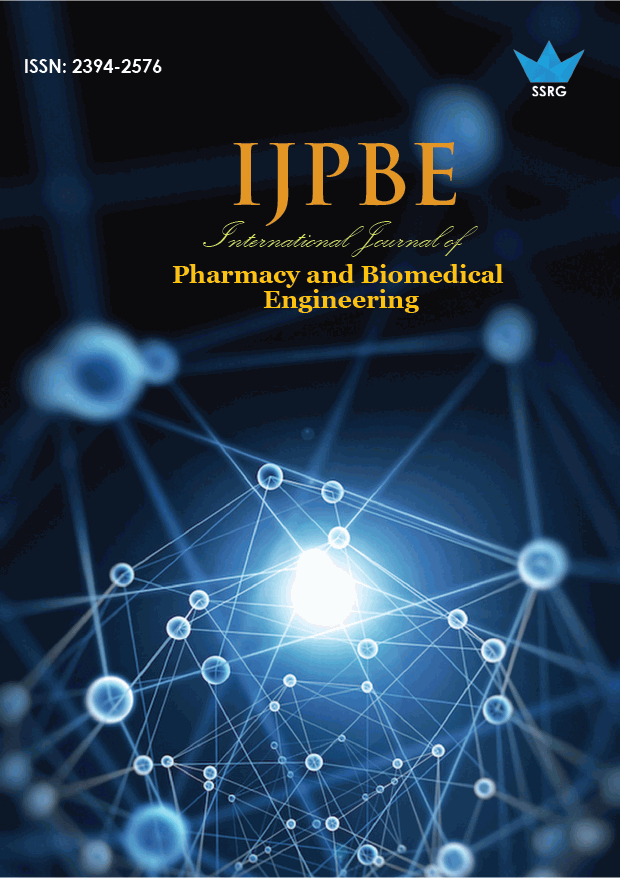A Modified Cage Insertion Device For Transforaminal Lumbar Interbody Fusion Surgery

| International Journal of Pharmacy and Biomedical Engineering |
| © 2021 by SSRG - IJPBE Journal |
| Volume 8 Issue 2 |
| Year of Publication : 2021 |
| Authors : Sangram A. Sathe, Amit C. Nemade, Soham V. Kulkarni, Swapnil P. Wadkar |
How to Cite?
Sangram A. Sathe, Amit C. Nemade, Soham V. Kulkarni, Swapnil P. Wadkar, "A Modified Cage Insertion Device For Transforaminal Lumbar Interbody Fusion Surgery," SSRG International Journal of Pharmacy and Biomedical Engineering, vol. 8, no. 2, pp. 6-10, 2021. Crossref, https://doi.org/10.14445/23942576/IJPBE-V8I2P102
Abstract:
Transforaminal Lumbar Interbody Fusion is the most widely used approach for treating Spondylolisthesis. Interbody fusion devices are inserted in the Lumbar region for degenerative disc diseases. Use of guideways makes the surgery more complex. The proposed insertion device is an attempt to eliminates the use of a guideway threby providing smooth and injury free surgical operation. The device performs two functions including positioning and holding the cage while performing the surgery. Positioning method and holding mechanism of the device are further discussed in the paper. Transforaminal Lumbar Interbody Fusion (TLIF) device provides suitable disc height and ensured the load bearing capacity of the spine maintained. The prposed device mechanism disclosed is effective to implement than using guideways. Moreover, the provided locking pins provide secure locking of the cage because of its excellent strength. The proposed insertion device is relatively simple and compact in design with maximum insertion tube diameter of 12 mm.
Keywords:
Degenerative Disc Diseases, Pedicle screw, Spine, Spondylolisthesis, Transforaminal lumbar interbody fusion (TLIF)
References:
[1] P. Tengvall, B. Skoglund, A. Askendal, P. Aspenberg, Surface immobilized bisphosphonate improves stainless-steel screw fixation in rats. Biomaterials, (2004) 2133–2138.
[2] V. K. Goel, N. A. Ebraheim (2005), Role of mechanical factors in the evaluation of pedicle screw type spinal fixation devices, Neurology India, 53(4) (2005) 399-407.
[3] John T. Lysack, David Yen, Genevieve A. Dumas, In vitro flexibility of an experimental pedicle screw and plate instrumentation system on the porcine lumbar spine, Medical Engineering & Physics (2000) 461–468.
[4] Ryken TC, Clausen JD, Traynelis VC, Goel VK, Biomechanical analysis of bone mineral density, insertion technique, screw torque, and holding strength of anterior cervical plate screws, J Neurosurgery, 83(1995) 324-9.
[5] Oleg Prymak, Denise Bogdanski, Manfred Köller, Stefan A. Esenwein, Gert Muhr, Felix Beckmann, Tilmann Donath, Michel Assad, Matthias Epple, Morphological characterization and in vitro biocompatibility of a porous nickel–titanium alloy. Biomaterials, (2005) 5801–5807.
[6] Thomas R. Haher, Amy W. Yeung, Danielle M. Ottaviano, Andrew A. Merola, Steven A. Caruso, The inverse effects of load transfer and load sharing on axial compressive stiffness. The Spine Journal, 1 (2001) 324–330.
[7] A. Rohlmann, G. Bergmann, F. Graichen, H.-M. Mayer, Placing a bone graft more posteriorly may reduce the risk of pedicle screw breakage: analysis of an unexpected case of pedicle screw breakage. Journal of Biomechanics, 763-767. evaluation of a new system to improve screw fixation in osteoporotic bones. Med Eng Phys, 10(1998) 1016
[8] screw breakage. Journal of Biomechanics, 763-767.
[9] Robert W. Gaines Jr., Use of Pedicle-Screw Internal Fixation for the Operative Treatment of Spinal Disorders. J Bone Joint Surg Am, 82 (2000) 1458.
[10] Divya V. Ambati et al. Bilateral pedicle screw fixation provides superior biomechanical stability in transforaminal lumbar interbody fusion. The spine journal (2014).
[11] Chad D. Cole et al. Comparison of low back fusion techniques: transforaminal lumbar interbody fusion (TLIF) or posterior lumbar interbody fusion (PLIF) approaches. Journal of Clinical Neuroscience 21 (2014) (2009) 441–444
[12] Timothy E. Lindley et al. Effect of steerable cage placement during minimally invasive transforaminal lumbar interbody fusion on lumbar lordosis. Journal of Clinical Neuroscience 21 (2014) (2013) 441–444.
[13] Keavenly TM, Bartel DL, Fundamental load transfer patterns for press-fit, surface-treated intramedullary fixation stems, J Biomechanics; 27 (1994) 1147–57.
[14] A. Yánez, J.A. Carta, G. Garcés, Biomechanical (2010).
[15] Pyung Goo Cho et.al. A morphometric analysis of contralateral neural foramen in TLIF. Journal of Clinical Neuroscience 24 (2015) 783–790 44
[16] Jong-Tae Kim et.al. Restoration of lumbopelvic sagittal alignment and its maintenance following transforaminal lumbar interbody fusion (TLIF): comparison between straight types versus curvilinear type cage. Eur Spine Journal 586-015-3899-9 (2015).
[17] Ling Wang et.al, Posterior short segment pedicle screw fixation and TLIF for the treatment of unstable thoracolumbar/lumbar fracture. Journal of Clinical Neuroscience 24 (2014) 783–790 44
[18] Cole, C.D., McCall, T.D., Schmidt, M.H. et al. Comparison of low back fusion techniques: transforaminal lumbar interbody fusion (TLIF) or posterior lumbar interbody fusion (PLIF) approaches. Curr Rev Musculoskelet Med 2, 118–126 (2009). https://doi.org/10.1007/s12178-009-9053-8
[19] Yadav S, Singh S, Arya RK, Kumar A, Kumar I, Jha A. Comparative analysis of transforaminal lumbar interbody fusion versus
posterolateral instrumented fusion in degenerative lumbar spine disorders. Journal of Orthopaedics, Trauma and Rehabilitation. December (2020) 173-178. doi:10.1177/2210491720941212
[20] Pooswamy, S., Muralidharagopalan, N.R. & Subbaiah, S. Transforaminal lumbar interbody fusion versus instrumented posterolateral fusion in Grade I/II spondylolisthesis. IJOO 51 (2017) 131–138 (2017). https://doi.org/10.4103/0019-5413.201703
[21] Liu, F., Jiang, C., Cao, Y. et al. Transforaminal lumbar interbody fusion using unilateral pedicle screw fixation plus contralateral translaminar facet screw fixation in lumbar degenerative diseases. IJOO 48, 374–379 (2014). https://doi.org/10.4103/0019-5413.136240
[22] Sun, K., Sun, X., Huan, L. et al. A modified procedure of single-level transforaminal lumbar interbody fusion reduces immediate post-operative symptoms: a prospective case-controlled study based on two hundred and four cases. International Orthopaedics (SICOT) 44, 935–945(2020). https://doi.org/10.1007/s00264-020-04508-x
[23] Tate M. Andres, Justin J. Park, Pedro A. Ricart Hoffiz, Brian J. McHugh, Daniel T. Warren, Thomas J. Errico, Cost analysis of anterior-posterior circumferential fusion and transforaminal lumbar interbody fusion, The Spine Journal, Volume 13, Issue 6, 2013, Pages 651-656, ISSN 1529-9430, https://doi.org/10.1016/j.spinee.2012.11.055.
[24] Mubarok, N. & Notonegoro, Hamdan & Thosin, K.. (2018). Comparative Mechanical Improvement of Stainless Steel 304 Through Three Methods. IOP Conference Series: Materials Science and Engineering. 367. 012023. 10.1088/1757-899X/367/1/012023.

 10.14445/23942576/IJPBE-V8I2P102
10.14445/23942576/IJPBE-V8I2P102